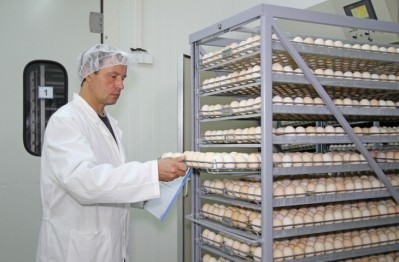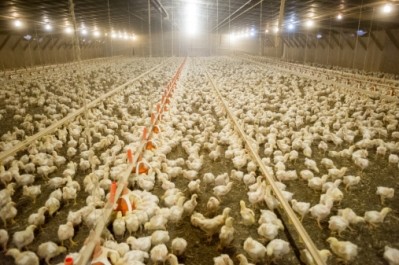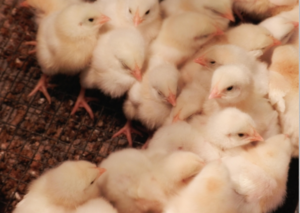Feeding strategies post hatch critical for future broiler performance, says Cargill
![Feed deprivation, especially during the first days after hatch, said to depress chick intestinal development [pic: (c) istock.com]](/var/wrbm_gb_food_pharma/storage/images/_aliases/wrbm_large/7/2/2/5/2655227-1-eng-GB/Feeding-strategies-post-hatch-critical-for-future-broiler-performance-says-Cargill.jpg)
In terms of poultry nutrition, the company said there is a growing body of evidence now to show the benefits for later productivity from feeding the correct balance of nutrients to newly hatched chicks from improving feed intake, to enhancing the development of the bird’s intestinal tract along with its immune system.
David Lamot, poultry research scientist at the Cargill Animal Nutrition (CAN) innovation center in the Netherlands, told us the optimal growth and development of a chicken can only be achieved when these are supported from the moment of hatch onward.
The first week after hatch counts for approximately 20% of the lifespan of modern broilers, emphasizing the importance of this period for subsequent performance, he said.
A 2014 Poultry Science published study Lamot conducted, in collaboration with researchers from Wageningen University and HatchTech in the Netherlands, indicated a mild delay in feed access after hatch affects growth and development during the first week after hatch.
“Feed deprivation, especially during the first days after hatch, depresses intestinal development on the short and long term, reflected by a lower intestinal weight, shorter length, lower enzymatic activity, altered villi and crypt cell density, and lower crypt depths and villi heights (Corless and Sell, 1999; Geyra et al., 2001; Gonzales et al., 2003; Maiorka et al., 2003),” wrote the authors.
The study also suggested early hatchers have a different developmental and growth pattern than midterm or late hatchers within a 24-hour hatch window.
Protein sources
CAN data and that of Batal & Parsons (2002b) shows that broilers benefit especially from highly digestible protein sources like corn gluten meal or potato protein during the prestarter-phase post hatch as their small intestine and their immune system, which are very much interrelated, are still maturing during the first week of life.
“And it is not only about adding some protein or tweaking the nutrient and mineral levels – it is more about the quality of the ingredients used in poultry pre-starters. It is also important to match the nutrient requirements to the physical status of the birds – you need to anticipate what the bird can handle, particularly the under-developed chick,” said Lamot.
As a global company, he said Cargill sees a lot of variety in different markets in terms of ingredient availability: “So we try to predict local conditions and work around that.”
In a trial CAN ran in the Philippines with young chicks, the feeding of a highly digestible potato protein based pre-starter saw growth in chick body weight of 7% in the first week, said Lamot.
And in another Cargill run study, this time in Malaysia, a BW gain of 17% was observed with young chicks fed a highly digestible pre-starter during the first week of their lives. The birds were also said to have maintained above average weight gain throughout other stages of their lives, and were found to be healthier and require less medication.
“Studies in the literature have shown a direct correlation between birth weight at seven days and weight at slaughter age in broilers,” added Lamot.
Pellet quality and size should also be given consideration in a pre-starter diet for chicks as such elements can help stimulate high early feed intake, he said. CAN research has shown that a small, preferably 2mm in diameter, ‘short cut’ pellet leads to the best results.
Embryonic nutrition
Dave Cook, global R&D director at CAN, said its poultry team is also continuing to investigate the impact of the hen's diet on the performance of its offspring.
“In-ovo allows us to do rapid screening of nutrients that might affect chick vitality at hatch as well as post hatch growth and efficiency of that growth,” he said.
Embryonic nutrition is somewhat a new avenue of research for the agribusiness giant.
In tandem with that focus, the CAN poultry team, said Cook, has also spent the past 12 months rolling out its Proviox Breeder product, a blend of polyphenols, into the global marketplace.
It is said to enable improved broiler growth performance with fewer broken eggs and better chick hatchability but original trials also showed that chicks are 2 to 4% heavier at hatch with reduced oxidative stress, which is evident by the increased glutathione levels in their livers. Such progeny was shown to grow faster, as well.
As microbiota plays an important role in broilers from the moment of hatch onward, Cook said understanding and managing gut function and health in broiler chicks is also an area of great interest for the CAN poultry scientists.
The CAN researchers have been leveraging deterministic models, he said, to help advance their understanding of gut integrity and how feed additives impact the gut barrier in an effort to find ways to manage the microbial population in the bird.












